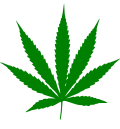Cannabis in Papua New Guinea: Difference between revisions
No edit summary |
Isseubnida (talk | contribs) →Further reading: Added template Tag: Reverted |
||
| Line 23: | Line 23: | ||
{{Portal bar|Cannabis}} |
{{Portal bar|Cannabis}} |
||
{{Oceania topic|Cannabis in}} |
|||
{{Cannabis by country}} |
{{Cannabis by country}} |
||
Revision as of 07:12, 23 November 2022
| Part of a series on |
| Cannabis |
|---|
 |
Cannabis in Papua New Guinea is illegal, but the nation is a significant producer and consumer of cannabis. Cannabis is sometimes called spak brus in local parlance.
History
Cannabis is believed to have been introduced to PNG by Australian and American expatriates in the 1960s-1970s.[1] From them the habit spread to locals, and by the 1980s cannabis could be bought in the major cities.[2]
Agriculture
Though cannabis can be grown throughout PNG, it is largely grown in the mountainous highlands from 1400-2200m in elevation, particularly in the drier areas of the highlands where it is said to grow a more powerful product.[2]
Economy
Cannabis is the only illegal drug produced in significant amounts in PNG, and is the most popular illegal drug consumed there; it is largely grown in Eastern Highlands, Western Highlands, and Southern Highlands provinces, and from there transported to other sites in the country.[3][4] Cannabis is produced for domestic use, as well as for export (primarily to Australia), and per some reports cannabis has been bartered for weapons.[5]
Cannabis is a lucrative cash crop[6] in PNG, and is exported to Australia across the Torres Strait. 1990 reports state the "PNG Gold" was valued at AU$12,000 per kilogram.
References
- ^ Mark A. R. Kleiman; James E. Hawdon (12 January 2011). Encyclopedia of Drug Policy. SAGE Publications. pp. 630–. ISBN 978-1-4522-6628-2.
- ^ a b R. Michael Bourke; Tracy Harwood (August 2009). Food and Agriculture in Papua New Guinea. ANU E Press. pp. 227–. ISBN 978-1-921536-61-8.
- ^ Beno Boeha; John McFarlane (2000). Australia and Papua New Guinea: Crime and the Bilateral Relationship. Australian Defence Studies Centre, Australian Defence Force Academy. p. 88. ISBN 978-0-7317-0439-2.
- ^ United Nations: International Narcotics Control Board (1 February 2007). Report of the International Narcotics Control Board 2006. United Nations Publications. pp. 84–. ISBN 978-92-1-148218-8.
- ^ International Narcotics Control Board (2002). Report of the International Narcotics Control Board for 2001. United Nations Publications. pp. 80–. ISBN 978-92-1-148145-7.
- ^ John Connell (28 July 2005). Papua New Guinea: The Struggle for Development. Routledge. pp. 73–. ISBN 978-1-134-93832-2.
Further reading
- Thomson, Ben (7 November 2014). "Polaroids from Papua New Guinea's Weed-Growing Highlands". Vice.
- Halvaksz a, Jamon; Lipset, David (2006). "Another Kind of Gold: An Introduction to Marijuana in Papua New Guinea". Oceania. 76 (Vol. 76, No. 3, Marijuana in Papua New Guinea (Nov., 2006), pp. 209-219): 209–219. doi:10.1002/j.1834-4461.2006.tb03051.x. JSTOR 40332031.
{{cite journal}}:|issue=has extra text (help) - Chen; et al. "Societal and health aspects of psychoactive drug abuse in Papua New Guinea" (PDF). Pacific Health Dialog. 6 (1): 93–100.